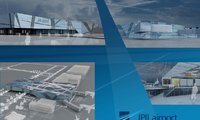The direct inspiration for this project are the streaks in the skies left by flying airplanes. These streaks are also symbolic of the roads of John Paul II, the Pilgrim Pope, whose name the airport bears.
The proposed project foresees the connection of the new terminal building and hotel into one synthetic block, into which a form reminiscent of a streak will be cut. The glass-covered area under the streak is to become the central part of the new terminal, and its own main hall together with the viewing terrace. This space is to link the new part of the terminal with the ones already existing, the pedestrian gangway, parking lot and the hotel.
The entire terminal has been designed of grey-blue glass, similar to the colour of the skies. Foreseen for the facade and roof is an image of manifold lines, bringing to mind streaks intersecting one another. The relation between the streaks and the backdrop before which they appear has been reversed. On the facade, the parts of the glass have been mated above the surface of the streaks, while on the roof the space beyond the streaks is concrete. Thanks to this, the streaks are built of colourless glass, intact, and remain a clear space in the structure of the building through which one can observe the surrounding world.
The astonishing effect of the definite division of the building works most of all because of its scale. The observer standing in front of the terminal, as well as in the central part of the building (i.e., in the glass streak), would see an enormous open space through it. From certain vantage points one would see airplanes taking off and others landing, from others the nose of the aircraft awaiting the arrival of passengers on-board. The block, breached in this way, opening before the viewer an immense space, would symbolise the lasting mark that John Paul II has left on us.






























